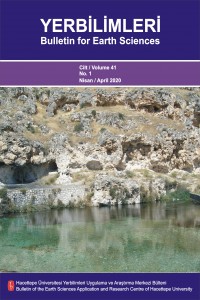Abstract
In open pit mining, excavations are generally carried out in two ways: direct excavation and excavation after loosening. Direct excavation is performed in areas with low rock strength, and in the opposite case, excavation operations are carried out after loosening by drilling-blasting. Which rock strength value should be performed for the loosening process is extremely important in terms of economic production. In this research, firstly, direct excavation experiments were performed with a dragline in an open pit coal mine that has work areas that have materials with three different rock strength values and without any discontinuity characterized. Then, in the same work areas, after drilling-blasting and loosening, the same dragline was used in the excavation. In both cases, unit excavation costs were calculated and compared, and it was found to be more economical to excavate after loosening at sites with uniaxial compressive strength of 9.80 MPa and higher.
Keywords
References
- Abdüllatif, O.M., Cruden, D.M., 1983. The relationship between rock mass quality and ease of excavation. Bulletin of the International Association of Engineering Geology, 28, 183-187. Bieniawski, Z.T., 1973. Engineering classification of jointed rock masses. The Civil Engineer in South Africa, 15, 335-343.
- Franklin, J.A., Broch, E., Walton, G., 1971. Logging the mechanical character of rock. Transactions of the Institution of Mining and Metallurgy, 80, A1-A9.
- Göktan, R.M., Eskikaya, Ş., 1991. Prediction of ripping machine performance in terms of rock mass properties. The Civil Engineer in South Africa, 31, 13-24.
- Karpuz, C., 1990. A classification system for excavation of surface coal measures. Mining Science and Technology, 11, 157-163.
- Kirsten, H.A.D., 1982. A classification system for excavation in natural materials. Die Siviele Ingenieur in Suid-Afrika, 82, 293-307.
- Müftüoğlu, Y.V., Scoble, M.J., 1985. Kömür açık işletmeciliğinde kazılabilirliği belirleme yöntemleri. Türkiye Madencilik Bilimsel ve Teknik 9. Kongresi, Ankara. 29-37.
- Pettifer, G.S., Fookes, P.G., 1994. A revision of the graphical method for assessing the excavatability of rock, Quarterly Journal of Engineering Geology. 27, 145-164.
- Singh, R.N., Denby, B., Egretli, I., Pathan, A.G., 1986. Assessment of ground rippability in opencast mining operations. Mining Magazine, University of Nottingham, 38, 21-34.
- Weaver, J.M., 1975. Geological factors significant in the assessment of rippability. Die Siviele Ingenieur in Suid-Afrika, 17, 313-316.
Abstract
Açık ocak madenciliğinde kazı işlemleri, genellikle direkt kazı ve gevşetme sonrası kazı olmak üzere iki şekilde yapılmaktadır. Kayaç dayanımı düşük olan sahalarda direkt olarak kazı yapılırken, tersi durumda ise delme-patlatma işlemiyle gevşetmeden sonra kazı operasyonları gerçekleştirilmektedir. Hangi kayaç dayanımı değerinden sonra gevşetme işleminin yapılması gerektiği üretimin ekonomik olarak yapılması açısından son derece önemlidir. Bu araştırmada açık işletme olarak çalışan bir kömür ocağında üç farklı kayaç dayanımı değerine sahip ve herhangi bir süreksizlik özelliği içermeyen bölgelerde çekme kepçeli yerkazar ile öncelikle direkt olarak kazı deneyleri yapılmıştır. Sonrasında ise aynı çalışma alanlarında delme-patlatma ile gevşetme yapıldıktan sonra yine aynı çekme kepçeli yerkazar ile kazı işlemi gerçekleştirilmiştir. Her iki durumda da birim kazı maliyetleri hesaplanarak karşılaştırma yapılmış ve tek eksenli basınç dayanımı 9,80 MPa ve daha yüksek olan sahalarda gevşetme işleminden sonra kazı yapılmasının daha ekonomik olduğu görülmüştür.
Keywords
References
- Abdüllatif, O.M., Cruden, D.M., 1983. The relationship between rock mass quality and ease of excavation. Bulletin of the International Association of Engineering Geology, 28, 183-187. Bieniawski, Z.T., 1973. Engineering classification of jointed rock masses. The Civil Engineer in South Africa, 15, 335-343.
- Franklin, J.A., Broch, E., Walton, G., 1971. Logging the mechanical character of rock. Transactions of the Institution of Mining and Metallurgy, 80, A1-A9.
- Göktan, R.M., Eskikaya, Ş., 1991. Prediction of ripping machine performance in terms of rock mass properties. The Civil Engineer in South Africa, 31, 13-24.
- Karpuz, C., 1990. A classification system for excavation of surface coal measures. Mining Science and Technology, 11, 157-163.
- Kirsten, H.A.D., 1982. A classification system for excavation in natural materials. Die Siviele Ingenieur in Suid-Afrika, 82, 293-307.
- Müftüoğlu, Y.V., Scoble, M.J., 1985. Kömür açık işletmeciliğinde kazılabilirliği belirleme yöntemleri. Türkiye Madencilik Bilimsel ve Teknik 9. Kongresi, Ankara. 29-37.
- Pettifer, G.S., Fookes, P.G., 1994. A revision of the graphical method for assessing the excavatability of rock, Quarterly Journal of Engineering Geology. 27, 145-164.
- Singh, R.N., Denby, B., Egretli, I., Pathan, A.G., 1986. Assessment of ground rippability in opencast mining operations. Mining Magazine, University of Nottingham, 38, 21-34.
- Weaver, J.M., 1975. Geological factors significant in the assessment of rippability. Die Siviele Ingenieur in Suid-Afrika, 17, 313-316.
Details
| Primary Language | Turkish |
|---|---|
| Subjects | Engineering |
| Journal Section | Articles |
| Authors | |
| Publication Date | April 27, 2020 |
| Submission Date | July 28, 2019 |
| Acceptance Date | April 27, 2020 |
| Published in Issue | Year 2020 Volume: 41 Issue: 1 |


